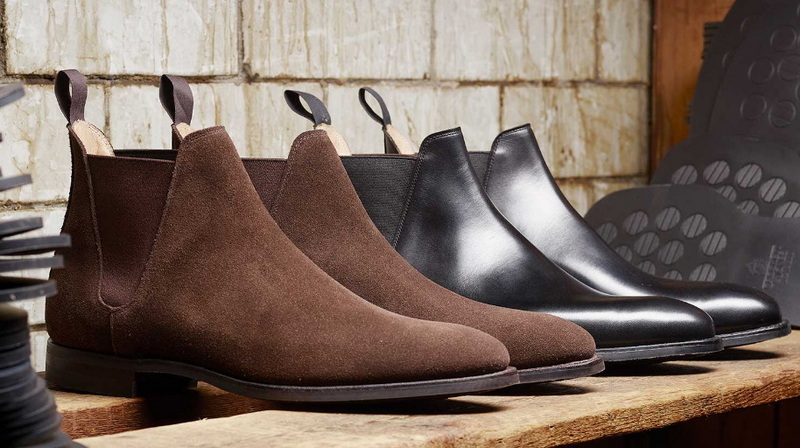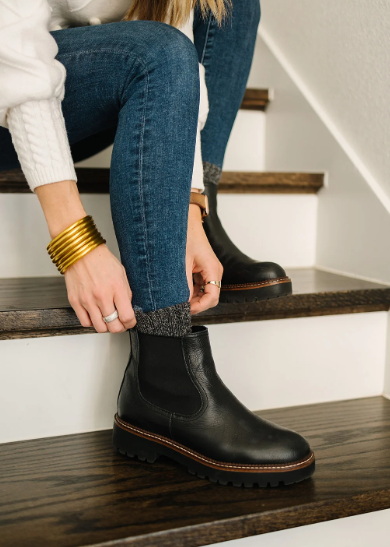Content Menu
● The Anatomy of a Chelsea Boot
● The Art of the Perfect Chelsea Boot Fit
>> Toe Box Comfort
>> The Heel Hold
>> Width and Overall Foot Embrace
>> Ankle Fit
>> The Instep
● How to Try On Chelsea Boots
● Breaking In Your Chelsea Boots
● Sizing Considerations
● Style and Fit
● Care and Maintenance for Optimal Fit
● Conclusion
● FAQs
>> 1. How much heel slippage is normal in new Chelsea boots?
>> 2. Can I wear orthotics or insoles with Chelsea boots?
>> 3. How do I know if my Chelsea boots are too big?
>> 4. Should Chelsea boots feel tight at first?
>> 5. How do I care for the elastic sides of my Chelsea boots?
● Citations:
Chelsea boots are a timeless classic in the world of footwear, known for their sleek design and versatility. Whether you're dressing up for a formal occasion or going for a casual look, these boots can elevate your style. However, to truly enjoy the comfort and aesthetic of Chelsea boots, it's crucial to understand how they should fit. In this comprehensive guide, we'll explore the nuances of Chelsea boot fit, from toe to heel, and provide you with expert tips to ensure you find the perfect pair.

The Anatomy of a Chelsea Boot
Before diving into the specifics of fit, let's briefly examine the key components of a Chelsea boot:
1. Elasticated Sides: The signature feature that allows for easy slip-on and off.
2. Ankle Height: Typically covering the ankle for added protection and style.
3. Pull Tabs: Located at the front and back to assist in putting on the boots.
4. Toe Box: Usually round or slightly tapered.
5. Heel: Provides support and defines the boot's silhouette.
Understanding these elements will help you assess the fit more accurately.
The Art of the Perfect Chelsea Boot Fit
Achieving the ideal fit for your Chelsea boots involves several key factors. Let's break them down:
Toe Box Comfort
The toe area is crucial for overall comfort. Here's what to look for:
- Allow approximately a thumb's width of space between your longest toe and the end of the boot[1].
- Your toes should be able to wiggle freely without feeling cramped.
- Avoid boots that pinch or constrict your toes, as this can lead to discomfort and potential foot problems.
The Heel Hold
A proper heel fit is essential for preventing slippage and ensuring stability:
- Your heel should feel secure with minimal movement.
- A slight heel slip is normal when the boots are new, but excessive movement indicates a poor fit[3].
- The boot's back should cup your heel comfortably without digging in.
Width and Overall Foot Embrace
The width of the boot is crucial for comfort throughout the day:
- The broadest part of your foot should feel cradled but not squeezed[1].
- Chelsea boots typically have a snug fit, but they shouldn't feel constricting.
- Remember that your feet may swell slightly during the day, so a bit of extra room is beneficial.
Ankle Fit
The ankle area is where Chelsea boots truly shine:
- The elasticated sides should hug your ankles gently but securely[1].
- There should be no significant gap between the boot and your ankle[5].
- The fit around the ankle keeps the boots on your feet, compensating for the lack of laces.
The Instep
Pay attention to how the boot fits across the top of your foot:
- The instep should feel snug but not tight.
- If you feel pressure on the top of your foot, the boots may be too small.

How to Try On Chelsea Boots
To ensure you get the best fit, follow these steps when trying on Chelsea boots:
1. Wear appropriate socks: Use the type of socks you plan to wear with the boots regularly.
2. Try them on later in the day: Your feet naturally swell as the day progresses, so afternoon fittings are ideal[3].
3. Use the pull tabs: These help you slip the boots on without damaging the elastic sides[3].
4. Walk around: Take a few steps to assess comfort and any potential slippage.
5. Check for pressure points: Pay attention to any areas that feel tight or uncomfortable.
Breaking In Your Chelsea Boots
Even with the perfect fit, new Chelsea boots may require a breaking-in period:
- Wear them around the house for short periods initially.
- Use a boot stretcher if you experience slight tightness[7].
- Be patient – premium leather will mold to your foot shape over time[1].
Sizing Considerations
Chelsea boot sizing can vary between brands and styles:
- Most Chelsea boots run true to size, but always check the brand's sizing guide[5].
- If you're between sizes, consider going down half a size for a snugger fit[2].
- Some brands offer different width options, which can be helpful for those with wider or narrower feet[3].
Style and Fit
The fit of your Chelsea boots can affect your overall look:
- A sleeker fit pairs well with slimmer pants and jeans.
- Avoid overly pointy toes if you have wider feet.
- Consider the boot's silhouette in relation to your foot shape and personal style.
Care and Maintenance for Optimal Fit
Proper care can help maintain the fit and extend the life of your Chelsea boots:
- Use shoe trees to maintain shape when not wearing.
- Clean and condition the leather regularly to prevent cracking and maintain flexibility.
- Rotate your boots to allow them to rest and retain their shape.
Conclusion
Finding the perfect fit for Chelsea boots is a balance between comfort and style. They should feel snug but not tight, with enough room for your toes to move freely. The heel should be secure, and the ankle should be hugged by the elasticated sides. Remember that a slight breaking-in period is normal, and premium materials will adapt to your feet over time.
Take the time to try on multiple pairs, walk around, and assess the fit carefully. With the right fit, Chelsea boots can be a comfortable and stylish addition to your wardrobe, suitable for various occasions and outfits.

FAQs
1. How much heel slippage is normal in new Chelsea boots?
A small amount of heel slippage (about 1/4 to 1/2 inch) is normal in new Chelsea boots. This will typically decrease as the boots break in and the sole becomes more flexible. However, if your heel is consistently lifting more than this, the boots may be too large[3].
2. Can I wear orthotics or insoles with Chelsea boots?
Yes, you can wear orthotics or insoles with Chelsea boots, but it's important to consider this when fitting. If you plan to use inserts, bring them along when trying on boots. You may need to size up to accommodate the extra thickness, or look for boots with removable insoles that can be replaced with your custom orthotics[6].
3. How do I know if my Chelsea boots are too big?
Signs that your Chelsea boots are too big include excessive heel slippage, your foot sliding forward in the boot when walking, and visible gaps around the ankle area. If you can easily fit more than one finger between your heel and the back of the boot, they're likely too large[3][5].
4. Should Chelsea boots feel tight at first?
Chelsea boots should feel snug but not uncomfortably tight when new. A slight resistance when putting them on is normal, but you shouldn't have to force your foot into the boot. Remember that leather boots will typically stretch and mold to your feet over time, so a initially snug fit is often ideal[3][6].
5. How do I care for the elastic sides of my Chelsea boots?
To maintain the elasticity and appearance of the side panels, avoid overstretching them when putting on or taking off the boots. Use the pull tabs instead. Clean the elastic gently with a soft brush or cloth, and avoid applying heavy leather conditioners to this area as it may degrade the elastic over time. If the elastic becomes loose, a cobbler may be able to replace or tighten it[1][7].
Citations:
[1] https://martindingman.com/pages/chelsea-boot-buying-guide
[2] https://www.reddit.com/r/Boots/comments/18fzehu/chelsea_boots_sizing/
[3] https://www.ahume.co.uk/blog/chelsea-boots-the-ultimate-buyers-guide/
[4] https://www.youtube.com/watch?v=V_AsxR9huX4
[5] https://www.shoezone.com/Images/Static/Blog/the-low-down-on-chelsea-boots-2.jpg?sa=X&ved=2ahUKEwjfiL3ZxdiKAxWOCnkGHbF1G38Q_B16BAgKEAI
[6] https://bootspy.com/how-should-chelsea-boots-fit/
[7] https://www.rydale.com/blogs/news/how-should-chelsea-boots-fit

















